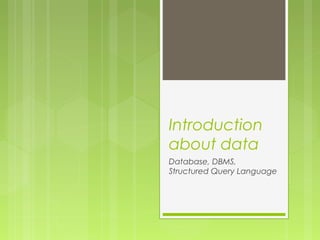Database
•Als PPT, PDF herunterladen•
0 gefällt mir•540 views
This document provides an introduction to databases, database management systems (DBMS), and structured query language (SQL). It defines a database as a collection of organized information that can be quickly accessed by a computer program. Databases are created to store, manage, and retrieve large amounts of information. A DBMS is a software system that allows users and applications to define, create, query, update, and administer a database. Well-known DBMSs include MySQL, SQL Server, and Oracle. SQL is a standard language for accessing and manipulating data within databases and allows users to perform functions like querying, inserting, updating, and deleting records.
Melden
Teilen
Melden
Teilen

Empfohlen
Empfohlen
Weitere ähnliche Inhalte
Was ist angesagt?
Was ist angesagt? (20)
Andere mochten auch
Andere mochten auch (9)
Ähnlich wie Database
Ähnlich wie Database (20)
SQL for Data Analytics: Mastering Queries and Reporting with Training

SQL for Data Analytics: Mastering Queries and Reporting with Training
Kürzlich hochgeladen
God is a creative God Gen 1:1. All that He created was “good”, could also be translated “beautiful”. God created man in His own image Gen 1:27. Maths helps us discover the beauty that God has created in His world and, in turn, create beautiful designs to serve and enrich the lives of others.
Explore beautiful and ugly buildings. Mathematics helps us create beautiful d...

Explore beautiful and ugly buildings. Mathematics helps us create beautiful d...christianmathematics
https://app.box.com/s/7hlvjxjalkrik7fb082xx3jk7xd7liz3TỔNG ÔN TẬP THI VÀO LỚP 10 MÔN TIẾNG ANH NĂM HỌC 2023 - 2024 CÓ ĐÁP ÁN (NGỮ Â...

TỔNG ÔN TẬP THI VÀO LỚP 10 MÔN TIẾNG ANH NĂM HỌC 2023 - 2024 CÓ ĐÁP ÁN (NGỮ Â...Nguyen Thanh Tu Collection
Kürzlich hochgeladen (20)
UGC NET Paper 1 Mathematical Reasoning & Aptitude.pdf

UGC NET Paper 1 Mathematical Reasoning & Aptitude.pdf
Explore beautiful and ugly buildings. Mathematics helps us create beautiful d...

Explore beautiful and ugly buildings. Mathematics helps us create beautiful d...
This PowerPoint helps students to consider the concept of infinity.

This PowerPoint helps students to consider the concept of infinity.
Mixin Classes in Odoo 17 How to Extend Models Using Mixin Classes

Mixin Classes in Odoo 17 How to Extend Models Using Mixin Classes
ICT role in 21st century education and it's challenges.

ICT role in 21st century education and it's challenges.
TỔNG ÔN TẬP THI VÀO LỚP 10 MÔN TIẾNG ANH NĂM HỌC 2023 - 2024 CÓ ĐÁP ÁN (NGỮ Â...

TỔNG ÔN TẬP THI VÀO LỚP 10 MÔN TIẾNG ANH NĂM HỌC 2023 - 2024 CÓ ĐÁP ÁN (NGỮ Â...
Vishram Singh - Textbook of Anatomy Upper Limb and Thorax.. Volume 1 (1).pdf

Vishram Singh - Textbook of Anatomy Upper Limb and Thorax.. Volume 1 (1).pdf
Unit-IV; Professional Sales Representative (PSR).pptx

Unit-IV; Professional Sales Representative (PSR).pptx
Basic Civil Engineering first year Notes- Chapter 4 Building.pptx

Basic Civil Engineering first year Notes- Chapter 4 Building.pptx
HMCS Max Bernays Pre-Deployment Brief (May 2024).pptx

HMCS Max Bernays Pre-Deployment Brief (May 2024).pptx
Salient Features of India constitution especially power and functions

Salient Features of India constitution especially power and functions
Database
- 1. Introduction about data Database, DBMS, Structured Query Language
- 2. What is Database A collection of information organized in such a way that a computer program can quickly select desired pieces of data. Traditional databases are organized by fields, records, and files.
- 3. What are database for? These are created to operate large quantities of information by inputting, storing, retrieving, and managing that information
- 4. How to use Database? Database Management System (DBMS) are specially designed applications that interact with the user, other applications, and the database itself to capture and analyze data. is a software system designed to allow the definition, creation, querying, update, and administration of databases. is responsible for maintaining the integrity and security of stored data, and for recovering information if the system fails. Well-known DBMSs include MySQL, MariaDB, PostgreSQL, SQLite, Microsoft SQL Server, Oracle, SAP, dBASE, FoxPro, IBM DB2, LibreOffice Base and FileMaker Pro.
- 5. The interactions catered for by most existing DBMS fall into four main groups: Data definition - Defining new data structures for a database, removing data structures from the database, modifying the structure of existing data. Update - Inserting, modifying, and deleting data. Retrieval - Obtaining information either for end-user queries and reports or for processing by applications. Administration - Registering and monitoring users, enforcing data security, monitoring performance, maintaining data integrity, dealing with concurrency control, and recovering information if the system fails.
- 6. What is SQL and its uses Acronym for Standard/Structured Query Language lets you access and manipulate databases SQL is an ANSI (American National Standards Institute) standard Lets you set commands to access specific or numbers of data for retrieval, even delete and update
- 7. What SQL can do? SQL can execute queries against a database SQL can retrieve data from a database SQL can insert records in a database SQL can update records in a database SQL can delete records from a database SQL can create new databases SQL can create new tables in a database SQL can create stored procedures in a database SQL can create views in a database SQL can set permissions on tables, procedures, and views